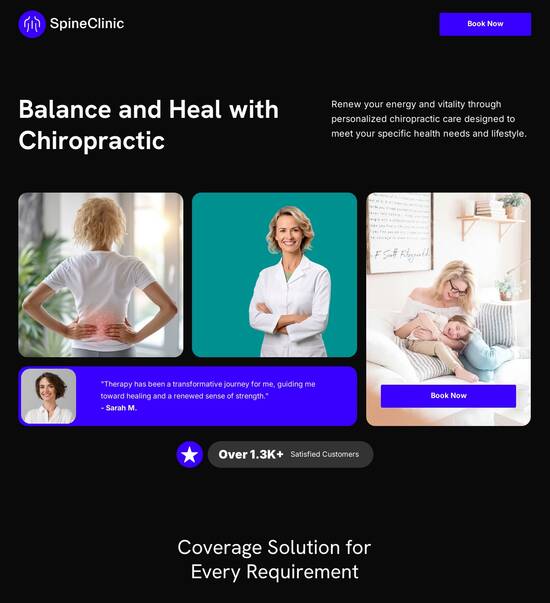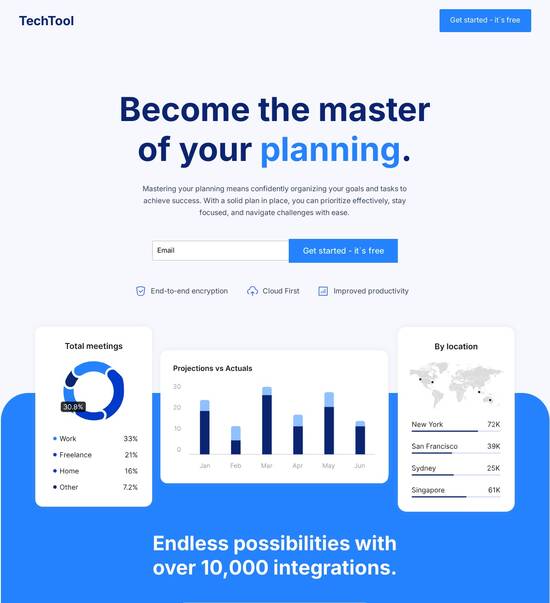
Glossary page template compatible with BigCommerce
Explore Similar TemplatesAbout template
Build and integrate high-converting glossary page templates with BigCommerce effortlessly!
Recommended templates

Easy to build without coding
With the intuitive drag-and-drop builder, anyone on your team can create high-converting pages without any knowledge of code or design. Make enhancements to your landing page with custom widgets using Javascript, HTML/CSS, or third-party scripts.

Multiple layouts for any industry and goal
Select from 500+ landing page layouts built to boost conversions across industry-specific scenarios. Customize them by adjusting fonts, adding images, and generating on-brand content with the AI assistant. Quickly scale with Instablocks® and Global Blocks that you can save, reuse, and update globally.

Loads fast and looks polished on any device
Every template is responsive, which means they present professionally on any device and load blazingly fast with our Thor Render Engine. You can also power them up with Google AMP technology to deliver an unparalleled mobile experience and drive higher conversions.

Robust analytics & experimentation
Get real-time updates and reporting across all your devices, showing the number of visitors, conversions, cost-per-visitor, and cost-per-lead. Launch AI-powered experiments, run A/B tests, and use heatmaps to analyze user behavior, then optimize your landing page to maximize conversions.







Easy to build without coding
With the intuitive drag-and-drop builder, anyone on your team can create high-converting pages without any knowledge of code or design. Make enhancements to your landing page with custom widgets using Javascript, HTML/CSS, or third-party scripts.
Multiple layouts for any industry and goal
Select from 500+ landing page layouts built to boost conversions across industry-specific scenarios. Customize them by adjusting fonts, adding images, and generating on-brand content with the AI assistant. Quickly scale with Instablocks® and Global Blocks that you can save, reuse, and update globally.
Loads fast and looks polished on any device
Every template is responsive, which means they present professionally on any device and load blazingly fast with our Thor Render Engine.
Robust analytics & experimentation
Get real-time updates and reporting across all your devices, showing the number of visitors, conversions, cost-per-visitor, and cost-per-lead. Launch AI-powered experiments, run A/B tests, and use heatmaps to analyze user behavior, then optimize your landing page to maximize conversions.
All the features you need to build lead-generating landing pages
Explore more featuresLearn how to build top-performing landing pages for any goal
FAQs
Leading the way in building high-performing landing pages





A comprehensive guide to landing page optimization with Instapage
Landing page optimization is crucial for maximizing the ROI of your digital marketing campaigns. Instapage offers an all-in-one landing page and CRO platform designed specifically to equip marketers across various industries—such as business services, tech, and education—with tools to enhance their campaign performance. This guide will provide a step-by-step approach to using Instapage effectively for creating high-converting landing pages.
Understanding landing pages and their importance
Landing pages are standalone web pages designed specifically for a marketing or advertising campaign. They are critical in guiding potential leads through the conversion funnel. By utilizing Instapage’s extensive library of templates and lead generation elements, marketers can create tailored landing pages that resonate with their audience.
- High-converting templates: Choose from 100+ ready-to-use templates designed for various industries to simplify the design process.
- Lead generation elements: Integrate forms and CTAs that capture valuable user information seamlessly.
- Analytics and optimization tools: Use heatmaps and A/B testing features to refine landing page performance.
Step 1: Utilize Instapage templates for quick launch
To kickstart your landing page creation, select a template that aligns with your campaign goals. Instapage simplifies the page creation process with its intuitive drag-and-drop builder.
Step 2: Optimize your content
Content is king. Ensure your landing page content is tailored toward your target audience by using dynamic text replacement. This feature allows you to personalize content, enhancing relevancy and engagement potential. Remember to incorporate action-oriented CTAs that guide users toward completing desired actions.
- Dynamic text replacement: Adjust key text elements based on user behavior or originating ad, creating a personalized experience.
- Effective CTAs: Use verbs that evoke action and urgency to capture leads.
- User-friendly layout: Use Instablocks to arrange essential elements without the need for coding.
Step 3: Collaborate for rapid deployment
Efficient collaboration is pivotal in enhancing your landing page's development cycle. Leverage Instapage’s real-time feedback tools that allow team members to leave comments and make edits quickly.
- Instant feedback: Facilitate immediate collaboration by sharing links with stakeholders for feedback.
- Real-time edits: Make live changes to your landing page as feedback is received, reducing turnaround time.
- Secure sharing: Maintain control over what information is shared outside your team, ensuring data privacy.
By following these strategic steps, marketers can effectively craft landing pages that drive conversions and enhance overall campaign success. It's essential to continually iterate based on performance analytics.
Ready to elevate your landing page strategy? Sign up for a free trial of Instapage today, and unlock your potential to create high-impact marketing campaigns that convert.
People also ask about Glossary page template compatible with BigCommerce
Glossary page template compatible with BigCommerce
Understanding the importance of a glossary page template in BigCommerce
Glossaries serve as vital resources in the eCommerce landscape, providing customers with definitions and explanations of terms that may be unfamiliar or industry-specific. By clearly outlining important phrases, businesses can demystify jargon and enhance customer understanding, ultimately leading to informed purchasing decisions. Customers appreciate easy access to terminology, especially in complex fields like technology and finance, where clear communication is essential.
A well-structured glossary page benefits both customers and search engine optimization (SEO). From a customer standpoint, it enhances usability; individuals can quickly find definitions relevant to their needs, guiding them through the purchasing journey. An SEO-optimized glossary page can drive traffic to your website by ranking for relevant search terms, increasing organic visibility and boosting your overall site authority.
BigCommerce provides an ideal platform for creating a glossary page. Its user-friendly interface and built-in tools facilitate easy content management and formatting. With customizable templates and design elements, businesses can ensure their glossaries are visually appealing and consistent with their branding. This integration emphasizes how a glossary can be seamlessly incorporated into a broader digital marketing strategy.
Key features of a glossary page template
Glossary pages in BigCommerce come with several key features that enhance their effectiveness and usability. One of the most notable features is the customizable layouts and design elements. Using Stencil, merchants can create responsive designs that adapt to various screen sizes, ensuring mobile users have a fluid experience. The drag-and-drop tools make it simple to edit and rearrange content without requiring extensive technical knowledge, empowering teams to maintain their glossaries actively.
Customizable layouts that facilitate branding.
Responsive designs ensure accessibility on mobile devices.
Drag-and-drop editing tools for easy content management.
Another important feature is the enhanced user experience (UX) provided by glossary templates. Customers can navigate through terms quicker due to alphabetical indexing, which organizes content logically. Additionally, advanced search functionalities help users find specific terms without scrolling through extensive entries. This sort of usability is crucial, especially considering a significant portion of visitors now access websites through mobile devices. A responsive glossary addresses these needs effectively.
Moreover, SEO optimization capabilities greatly benefit businesses using a glossary page template. Businesses can leverage keyword usage strategically to improve page rankings. Each glossary term can include meta tags and descriptions that enhance visibility in search results. Incorporating long-tail keywords into glossary entries can serve as powerful tools in positioning content to appear in relevant search queries, thereby expanding reach and traffic.
Building the glossary: step-by-step guide
Building an effective glossary starts with identifying essential terms and phrases that resonate with your target audience. Engage with your marketing team and industry communities to gather feedback on commonly used terminology. Conducting Q&A sessions can reveal frequently asked questions among customers, helping to establish a more comprehensive list of terms.
Collaborate with teams to compile a list of relevant terms.
Use customer feedback to prioritize glossary content.
Identify industry-specific jargon to enhance depth.
Once you have categorized key terms, it's time to create content for the glossary. Write clear and concise definitions that accurately convey meanings. Each entry should ideally go beyond just a simple definition, incorporating links to related resources or product pages for added context. Maintain an engaging tone to make the content accessible and reader-friendly.
Utilizing technology for content integration can significantly enhance your glossary's features. BigCommerce provides various tools for seamless content management. Furthermore, exploring plugins and third-party applications can enrich the user experience. Lastly, monitoring performance with analytics will help you understand user interactions with the glossary, giving you valuable insights on what to improve or update.
Utilizing the glossary page template for maximum impact
Once your glossary is live, it's crucial to promote it effectively within your website. Organize it in a way that aligns with user needs, such as placing it prominently in the navigation menu. This ensures easy access, increasing the likelihood that visitors will engage with it. Additionally, consider leveraging content marketing strategies to attract users to the glossary; blog posts, social media teasers, and newsletters can guide traffic back to this critical resource.
Engagement doesn't stop at creation; ongoing collaboration with internal teams can ensure the glossary remains current. This includes soliciting feedback from employees involved in customer interactions, as their insights can lead to discovering new terms or areas requiring clarification. Regular reviews of the glossary will help keep the content relevant, enhancing the resource's authority and usability over time.
Case studies: successful glossary implementations in BigCommerce
Examining successful glossary implementations reveals how businesses can effectively leverage this tool. For example, a leading tech retailer integrated a comprehensive glossary into their website, resulting in noticeable improvements in customer engagement metrics and sales conversions. By addressing customer knowledge gaps and providing easy access to information, they supported informed purchasing decisions, boosting customer trust and loyalty.
Another company in the beauty industry showcased how a well-maintained glossary enhanced the customer shopping experience. By regularly updating terms and incorporating user feedback, they utilized the glossary as not only an informational resource but also as a tool that guided customers toward products, ultimately increasing conversion rates. These case studies exemplify that thoughtful implementations can lead to measurable results, emphasizing the glossary's role in eCommerce.
Addressing common questions about glossary page templates
Businesses often want to know how to tailor their glossary pages to fit their specific needs. Customization can begin by analyzing competitor glossaries and identifying elements that stand out. Based on industry characteristics, businesses can opt for unique visual designs and layouts that resonate with their audience. Adjusting the aesthetic while keeping functionality at the forefront ensures users have a pleasant experience.
Consider the tone and style that best represent your brand.
Evaluate the use of colors, fonts, and images for aesthetic appeal.
Utilize customizable elements to keep your glossary distinct.
Challenges can arise during the glossary creation process, such as difficulties in content compilation. Establishing a detailed plan before starting can prevent inconsistencies. Engage with team members to delegate tasks and share content responsibilities, ensuring a more effective and efficient process. Additionally, navigating technical issues might pose obstacles; however, utilizing BigCommerce support resources can guide businesses through any challenges.
Continuous evolution of glossary content is essential for relevance over time. Implementing a regular review schedule aids in identifying outdated entries or terms that need refining. Engaging with customers for feedback on glossary usability can yield insightful suggestions that further enhance the content. This commitment to transparency not only enriches the glossary but also builds customer loyalty, showing that businesses value input and ongoing improvement.
Building a collaborative environment around glossary content
Creating a definitive glossary isn't a task for a single person; it demands teamwork and collaboration. By encouraging contributions from various team members, businesses can enhance knowledge bases and enrich glossary details. This collective effort not only engages employees but also fosters a sense of ownership in the content they help produce, which can lead to higher standards of quality.
Community engagement also plays a vital role in maintaining an effective glossary. Taking advantage of collaborative tools can encourage discussions surrounding glossary terms, allowing both customers and employees to interact and share insights. Making this space for collective knowledge encourages familiarity and builds a sense of belonging among users—a key factor in customer satisfaction.
FAQs: unlocking the potential of your glossary page template
Anticipating potential user questions can facilitate a smoother user experience. Creating a dedicated FAQ section on the glossary page allows businesses to address common queries, such as how to navigate the glossary or the process for suggesting new terms. This proactive approach helps reduce repetitive inquiries, saving time for both customers and support staff.
Utilizing FAQs effectively can also enhance SEO efforts. By integrating keywords related to frequently asked inquiries, businesses can boost visibility in search results. Presentation is crucial; using clear and organized formats helps improve readability and usability, ensuring users can quickly find the answers they need.
Leveraging analytics to measure glossary page effectiveness
Monitoring key metrics is essential for evaluating the success of your glossary page. Businesses should track user engagement metrics, such as the number of visitors, time spent on the glossary, and bounce rates. These data points provide insights into how well users interact with the glossary and whether it meets their informational needs effectively.
Utilizing analytics tools can also help refine the glossary content over time. Insights gathered from user behavior can inform decisions on which entries require expansion or increased prominence. Ultimately, aligning glossary performance with overarching marketing goals can facilitate strategic improvements, further enhancing user experience and maintaining a competitive edge in the market.
Ready to skyrocket conversions?
Supercharge your ad campaigns with high-performing landing pages
Get started














